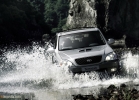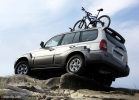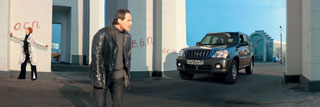Hyundai Terracan test drive since 2004 SUV
Ruler
 The Korean auto industry began the expansion in the world market, offering models that differed from competitors (with the same dimensions and sulfillization) of a noticeably lower and ... corresponding quality (consequence of the use of cheap labor and low production culture). However, these machines were successful, especially in developing countries. Over time, Koreans changed the strategy wishing to compete with European and Japanese manufacturers on equal terms, they seriously worked on the quality of their cars. Prices and prices were pulled up ...
The Korean auto industry began the expansion in the world market, offering models that differed from competitors (with the same dimensions and sulfillization) of a noticeably lower and ... corresponding quality (consequence of the use of cheap labor and low production culture). However, these machines were successful, especially in developing countries. Over time, Koreans changed the strategy wishing to compete with European and Japanese manufacturers on equal terms, they seriously worked on the quality of their cars. Prices and prices were pulled up ... An example of the Korean product of the new generation of Hyundai Terracan (Terra Earth, the second part of the name is a derivative of the Khan Tsar, ruler). Outwardly, the car looks okayly tailored, a body with the right, verified proportions, however, is somewhat boring. Only the original and very pretty optics from the back, for example, under a transparent colored cap, visually revive the appearance, are visible embossed reflectors and light bulbs with special-lamps. Everything is very high quality and beautiful. A machine with a gasoline engine, in contrast to the option with a diesel engine on its hood, there is no additional air intake so, in my opinion, even better.
Access to the salon opens a wide door, but crossing the opening does not very conveniently interfere with a high threshold. In addition, the bandwagon is too narrow, so you will not really step on it. At the same time, she protrudes beyond the threshold so as not to stain trousers, she has to be far back up. But these disadvantages seem small when you occupy a driver's seat. The salon is made in the best traditions of European firms, somewhat reminiscent of Audi interiors. The laconic, almost direct torpedo no riot of forms, so beloved by Koreans. A neat instrument shield towards the driver nothing superfluous: a speedometer, a tachometer, fuel level indicators and engine temperature. The section of the steering wheel is selected competently, it itself, like the central console, is decorated with decorative inserts for wood. This decoration looks by no means vulgar (as it often happens) on the contrary, even exquisite. Good viewing thanks to high landing and large glazing areas.
On the central console there is a radio (good sound), under it a small box for trifles, even lower than an electronic microclimate control unit with distinct symbols on the display and simple control. The ashtray was made in an adult in microlifts, it is advanced after a slight touch. In the central tunnel, in addition to the automatic transmission selector, there are a rotating transmission control handle and it is not clear which wind here is the button for turning on the cleaner and the washer of the rear window.
 In the second row, if you can leave the armrest, three will be applied quite, but in the middle it will not be too convenient for both the seat and the back are shaped for two. In addition, it is better to plant people no higher than 185 cm, otherwise the rear passengers will rest their knees in the backs of the seats. (There is a seven -seater version of the car with a third series of seats to imagine this is difficult.) Terracan freight capabilities are determined by a rather spacious trunk and the rear seats folding in parts. For small things in the cargo compartment there is a special net. The reserve is located under the floor of the trunk, with access from the street, so in which case it is not necessary to unload the car.
In the second row, if you can leave the armrest, three will be applied quite, but in the middle it will not be too convenient for both the seat and the back are shaped for two. In addition, it is better to plant people no higher than 185 cm, otherwise the rear passengers will rest their knees in the backs of the seats. (There is a seven -seater version of the car with a third series of seats to imagine this is difficult.) Terracan freight capabilities are determined by a rather spacious trunk and the rear seats folding in parts. For small things in the cargo compartment there is a special net. The reserve is located under the floor of the trunk, with access from the street, so in which case it is not necessary to unload the car. Now let's see what successes the Koreans have achieved in improving the chassis (all the Korean machines I have to deal with, Santa Fe, for example, were with a soft, roller suspension and thoughtful automatic machines that can spoil the impression even from a very good motor). It should be noted here that Terracan is structurally different from other Hyundai all -wheel drive machines. If his ancestor Galloper has a classic supporting frame, and Santa Fe carries a body, then Terracan has the so -called Integrated frame welded into the body.
I drive a seat for myself, which has at least some side support, and is not lined with so slippery skin as the predecessors. The main advantage of the car is a new 3.5-liter 200-horsepower V6 motor (before the rulers of the Earth met only 2.5- or 2.9-liter turbodiesels). The gasoline engine is very elastic and burden, reacts to the movement of gas pedals without delay and regardless of the speed of movement. In his work, he helps (and does not interfere, as on some other models), an automatic machine. He imperceptibly moves to the programs in the region of 2500 rpm. With calm movement and allows the engine to unwind to almost 6000 rpm. With intense acceleration. In Kick-Down mode, the box quickly, almost without delay, goes one or two gears down, which tells the car the maximum possible acceleration. The suspension was also pleased with the elastic, energy -intensive, moderately tough, it easily copes with all road problems, avoiding breakdowns, and in corners it holds the body from strong rolls.
The steering compromise between road and off -road requirements, with roll towards the former. From a click to a click of 3.8 turns ...
 Not for the season, spring weather allowed some off -road experiments on summer tires. Before telling them, some digression should be made. If you remember, a couple of years ago, when the car existed only in the rank of concept, it spoke under the name Hyundai Highlander. The serial version called Terracan appeared before journalists (but not in front of the public) last year in Geneva. With this name, he went on sale, but not everywhere, in some markets two models of simple Terracan and the more perfect and expensive Terracan Highlander are offered. Their difference is in all -wheel drive systems, and the difference is important, although not too advertised by the company.
Not for the season, spring weather allowed some off -road experiments on summer tires. Before telling them, some digression should be made. If you remember, a couple of years ago, when the car existed only in the rank of concept, it spoke under the name Hyundai Highlander. The serial version called Terracan appeared before journalists (but not in front of the public) last year in Geneva. With this name, he went on sale, but not everywhere, in some markets two models of simple Terracan and the more perfect and expensive Terracan Highlander are offered. Their difference is in all -wheel drive systems, and the difference is important, although not too advertised by the company. The simple Terracan drive with a rigidly connected front bridge calls it EST (Electric Shift Transfer). You can turn on all -wheel drive from the driver's seat at speeds up to 80 km/h, while the torque is distributed between the axes in a ratio of 50:50.
The Terracan Highlander system is more complicated by the constant ATT all -wheel drive (Active Torque Transfer), in which the front bridge is connected smoothly and automatically if the rear wheel slipping begins. In particularly difficult cases, it is supplied to it up to half of the torque. If desired, the front bridge can be turned on constantly.
The steep version of the machine from the outside is characterized by a chrome grate of the radiator and door handles, and inside a leather salon and wooden trim. As you already guessed, it was she who was on our test, albeit without a prefix in the name ...
 It turned out that Terracan’s cross -country ability is very good, you only need to turn on a lower gear in time. But the largest buzz is to grab in the backward snow without turning on the reducing and blocking. In this mode, Hyundai is almost rear -wheel drive, the front bridge is connected only with strong slipping. At the entrance to the turn, push the gas pedal to the floor to break the stern, and then you do not let it go, working only by the steering wheel. It seems that the drift angle is about to exceed critical, but here the front wheels are connected by throwing the fountains of snow slush, they pull the car. The main thing is not to be scared and wait for the front to connect. In general, this car can give real pleasure a more or less advanced driver.
It turned out that Terracan’s cross -country ability is very good, you only need to turn on a lower gear in time. But the largest buzz is to grab in the backward snow without turning on the reducing and blocking. In this mode, Hyundai is almost rear -wheel drive, the front bridge is connected only with strong slipping. At the entrance to the turn, push the gas pedal to the floor to break the stern, and then you do not let it go, working only by the steering wheel. It seems that the drift angle is about to exceed critical, but here the front wheels are connected by throwing the fountains of snow slush, they pull the car. The main thing is not to be scared and wait for the front to connect. In general, this car can give real pleasure a more or less advanced driver. Unlike the Santa Fe parquet, the new Hyundai product is not only a full -fledged city car, but also a quite serious SUV. According to the ideology and design of the Hyundai Terracan, it is very close to Mitsubishi Pajero Sport, but Mitsubishi costs higher than the same prices in the world's tables, and at almost the same prices (Terracan in the described configuration costs $ 39.900) The choice of the customer will most likely be obvious (we advise you Transmission features). Change the established consumer image The task is much more complicated than just improve the design or improve quality, it takes time.
Alexander Nadens
A source: Motor magazine [March 2002]







